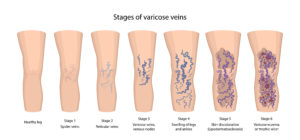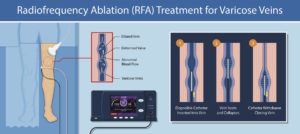If the blood circulation in a patient’s veins becomes impeded or — in some cases— flows backward, they have developed a venous disease. In such cases, the internal pressure placed on the damaged and/or weakened vein walls causes a range of symptoms, both physical and cosmetic in nature.
Most commonly, patients develop one or both of the following:
● Spider Veins — Occurs when stagnated blood causes web-like discolorations of purple, blue, and/or red beneath the skin
● Varicose Veins — Occurs when the slowed blood flow causes the veins to twist and bulge

Venous Disease Treatment Options
Sclerotherapy
Sclerotherapy is most often used as a targeted treatment option for spider veins. This method utilizes a sclerosant, or chemical irritant, which is injected directly into the diseased veins. The sclerosant interacts with the tissue of the vein walls, thereby causing them to collapse and reroute the blood flow through neighboring venous systems that are functioning optimally.
Sclerotherapy also…
● Often requires two to five sessions in total
● Features no scarring
● Requires little-to-no downtime post-procedure
● Offers long-lasting results
● And more
RF Ablation
Radiofrequency ablation (or simply referred to as RF ablation) is the process by which a physician will utilize short bursts of radiofrequency energy to close or “ablate” the weakened veins. By targeting the collagen located in the vein walls, RF ablation is both efficient and effective in altering the flow of blood circulation to instead flow through the healthier neighboring veins.
Often used in conjunction with sclerotherapy, RF ablation is also a minimally-invasive treatment.
 Deep Venous Disease
Deep Venous Disease
Should the above treatments not entirely offer the patient relief, they may still have an underlying condition that exists within their deep venous system. Thus, our physician will inject contrast into their veins as a means of monitoring their circulation with ultrasound. Once diagnosed, this process may then involve balloon angioplasty, stenting, and/or atherectomy as is necessary.